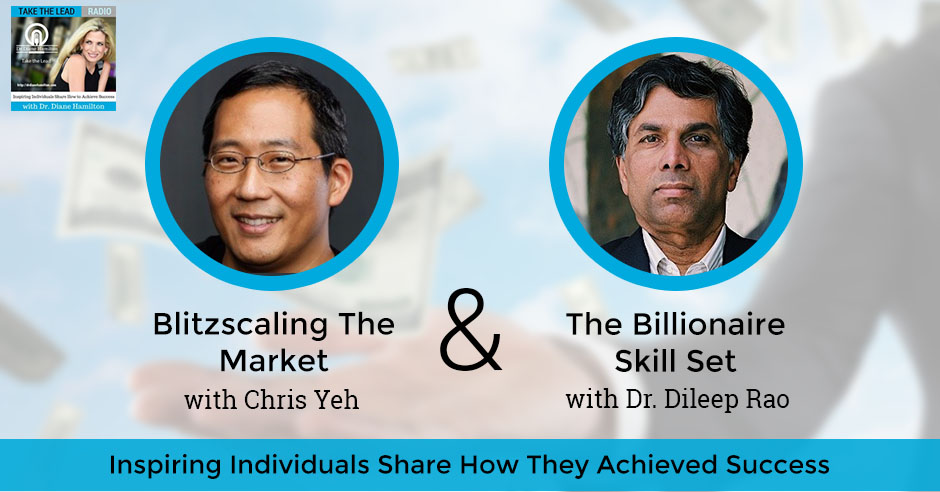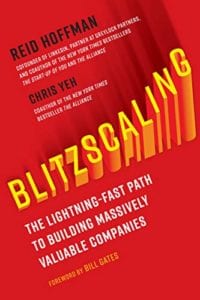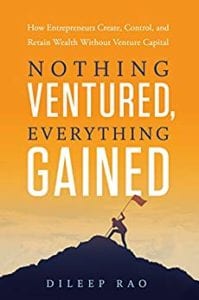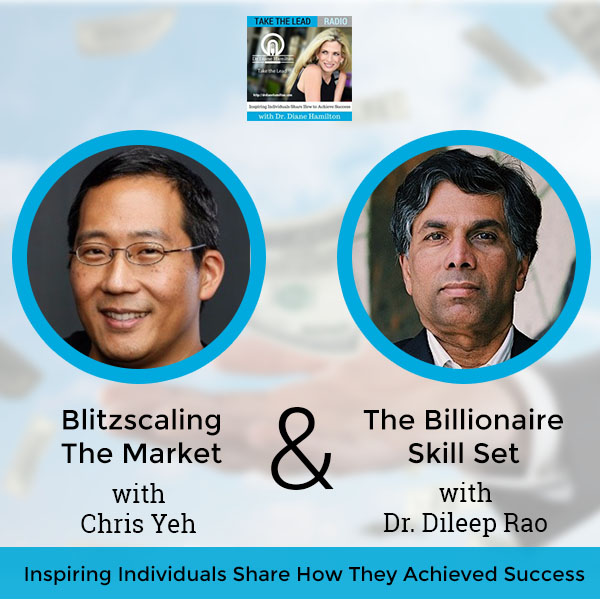
We have two amazing professors, authors and speakers on the show. Chris Yeh and Dr. Dileep Rao. Chris is the co-author with Reid Hoffman of Blitzscaling. Dileep is the author of Nothing Ventured, Everything Gained. These two are so famous in their own right and what they’ve written are amazing works. I’m looking forward to chatting and we will talk to both of them.
Listen to the podcast here
Blitzscaling The Market with Chris Yeh

Blitzscaling: The Lightning-Fast Path to Building Massively Valuable Companies
am here with Chris Yeh who is an investor, writer, mentor and entrepreneur. He and Reid Hoffman co-authored Blitzscaling: The Lightning-Fast Path to Building Massively Valuable Companies. It’s nice to have you here, Chris.
It’s great to be here, Diane. It’s a pleasure to be on the show.
Don’t you two teach a course at Stanford about blitzscaling?
We taught a class at Stanford on blitzscaling, which is where the book came from. A couple of years ago we felt like there is this phenomenon where companies are growing faster than ever before. The perfect way to learn about it was to teach a course about it. We taught a course with guests like Eric Schmidt, the former CEO and Chairman of Google, Brian Chesky, the Founder of Airbnb and Diane Green, the Founder of VMware. We had these great people come into the classroom and we were able to get them to share their wisdom with the students, but also to give us wisdom that we can then include it in our book.
That would be great to take that class. I imagine there was quite a waiting list for that. I’ve had a lot of people on my show who teaches at Stanford. I know you have your MBA from Harvard and you’re connected to some of the best of the best. You had Bill Gates wrote your foreword in your book. That’s quite a feat to have him right there.
I can’t claim credit for that. Since Microsoft bought LinkedIn, Reid serves on the board with Bill and Satya and the rest of the crew over there at Microsoft. He was kind enough to provide a foreword, which means a lot. You could not find a better person to write about building a massively valuable business than Bill Gates.
I was reading it. He talks about two-sided business models like they have at LinkedIn, Airbnb and Uber. It’s an interesting foreword and he did a great job with it. I want to give a little background on you before we get into the book. First of all, I know you have blogs. I found your older one where they could ask you anything. I love that it says, “My name is Chris Yeh. I am a Harvard MBA and you can ask me anything.” I’m curious about that. We might have to find out what the most interesting question was that anybody asked you. Before we get to some of your writing and the book, can you give a little background about you? You have an MBA from Harvard and you wrote an incredible book with Reid Hoffman. How did you get to that point?
I grew up in Southern California in Santa Monica. I came up to Stanford for my undergrad. It was a dream come true to teach at my alma mater. When I left Stanford, I jumped into the world of the internet and internet entrepreneurship. I’ve been there ever since. A lot of the lessons that we learned are drawing on the experiences that Reid and I had. Reid had these legendary experiences, but I was also in that same world at the same time. Those shared experiences helped us.
How did you get connected with Reid initially?
When LinkedIn first came out, I was a big fan of the service. Ironically enough, I tell people the biggest financial mistake in my life is, at that point in time, not saying, “Could I invest in the company? Could I take a job at the company?” because I was a big fan. I liked what they were doing. All I did was advocate for the company and have Reid come and speak at various Harvard Business school events and things like that. I helped LinkedIn along, but I did not benefit directly in a way that would have been very lucrative. That’s how I got to know Reid. I thought that LinkedIn was a fascinating service. I thought it was a great service for the Harvard Business School alumni. I got to know Reid and the rest of the founders there because they were also Stanford alumni.
There’s an amazing group of people. You talked about a lot of things in your blog or write about in your book of interesting stories. I want to get into blitzscaling because a lot of people are interested. Just the title is fascinating. What you’re trying to do instead of getting from zero to one, you’re going to some of these massive companies conceivably in a short period of time. You talked about how to get there. I’d like to know what led to your interest in having the course in this that led to the book. Reid had this amazing background with LinkedIn and his success, but have you always been interested in watching some of these giant companies and what they go through?
[bctt tweet=”Done is better than perfect, and now is better than tomorrow.” username=””]Both Reid and I share a lot of similarities in our background. We both are alumni of Stanford University. We both went through the same program, Structured Liberal Education, which is this intensive intellectual program. Reid was five years ahead of me in school. We never overlapped there. We went through and took many of the same classes and worked with some of the same professors. What was interesting to us was this paradox, which was even as all these companies were growing incredibly rapidly and Silicon Valley was becoming more prominent and the tech was becoming more prominent, people didn’t have a good explanation for why. If you said, “What is behind this?” they would say things like, “This is a great place to start companies and it’s a culture that is tolerant to failure. There are these brilliant people at these universities.” Those are all explanations that are partially true, but they’re also true of a lot of other places. We said, “There’s something going on here that people are overlooking.” What we have to do is we have to investigate and figure out what it is that has enabled Silicon Valley to produce so many of the world’s most valuable companies.
I’d like to know what that is as well because we saw that the Midwest was the former Silicon Valley, with the car industry and everything back in the day. Now, Silicon Valley is so big and we’re starting to see other areas growing. Why do you think Silicon Valley has had so much success?
We attribute it to the changes in the market dynamics. When the internet came about, it connected everyone and everything together. It meant that ideas and products could spread faster and further than ever before, which meant that more and more markets are global. More and more markets are instantly winner-takes-most or winner-takes-all. A winner-takes-most or winner-takes-all market acts very differently than other markets. If you have a winner-takes-most or winner-takes-all market, the most important thing is to be the first person to reach some critical scale. If you achieve that, then you have an enduring market leadership that could hold up for years or even decades. The majority of the value creation in that particular industry is going to accrue to you, which means there’s a huge and enormously valuable prize that goes to whoever is the fastest. Silicon Valley, for a lot of historical reasons, was better versed in the art of aggressively moving as quickly as possible. In the book, we define it as prioritizing speed over efficiency even in an environment of uncertainty.
When you think of Facebook versus Myspace, is it better to be not the first one in the market? Is it better to learn what someone else has done and you improve upon it? What did you find in that respect?
The evidence is very clear that the first mover is usually not the company that first becomes the enduring market leader. Being the first mover sometimes does lead to this, but in many cases, it doesn’t. It’s because it’s that ability to be the first to scale that’s most important. For example, Apple didn’t produce the first personal computer. Apple didn’t produce the first smartphone and yet now, Apple is synonymous with those things. Google wasn’t the first search engine. Peter Thiel said Google wasn’t the first search engine but it’s the last search engine. It’s better to be the last than the first and the one that builds that enduring franchise.
Who do you think competed with LinkedIn? Why do you think LinkedIn was such a success?
LinkedIn was successful because Reid had a couple of core beliefs that turned out to be right. There were other companies that were in this space. For example, there was a company called Plaxo that was in the social networking space. Plaxo thought at the core element of business social networking was the address book. It was important for companies to be able to share the address books of its employees. That was their bet. Comcast back then eventually bought that company. In contrast, Reid had this strong belief that in the future professionals will manage their own networks. LinkedIn is individual-centric as opposed to company-centric. That’s one of those core distinctions that allowed LinkedIn to be successful. The other core insight that Reid had when he built LinkedIn was it had to be based around your real identity. That went very different than what happened after that point as people said on the internet no one could tell you’re a dog. LinkedIn was the first service that said, “You need a place for your real identity online so that people can reach you and can find you for these economic opportunities.” LinkedIn provided a professional way to generate that when there weren’t a lot of other options.

Blitzscaling: Sacrificing efficiency for the sake of speed is counterintuitive.
It’s interesting to see the success of Reid Hoffman and Elon Musk, all these names that we talk about and any of the PayPal original group. I know you wrote about the inefficiency at Amazon, helping them in different things that would probably be counter-intuitive to what we would think has been something that helps an organization. Can you address that a little bit?
One of the things we talk about is because blitzscaling is about sacrificing efficiency for the sake of speed, which is pretty counter-intuitive and doing it in an environment of uncertainty, which is also counter-intuitive. It means that you have to turn a lot of the rules of business on their head. Once you make this assumption that you’re going to do something that is contrary to the traditions of business, you have to do a lot of other things that are contrary to the traditions of business. We have a list of these counter-intuitive rules in the book that include things like launching a product that embarrasses you or ignores your customers. The core behind all of them is you do something that you normally wouldn’t do because it allows you to move faster. It always gets back to that core need for speed.
What’s an example of a product that would embarrass someone?
A classic example here is LinkedIn itself. Reid drew on his previous experience. He had a prior social network called SocialNet. That was actually his first startup. LinkedIn was not his first startup. It took place years and years earlier in 1996. With SocialNet, Reid tried very hard to polish the service and make it perfect before he pushed it out. His experience was, “I’m not Steve Jobs. I don’t have the ability to magically know in advance what people want.” That’s true of Steve Jobs as well. People forget the original iPhone launched without an app store. There is no third party to start. What we realized is the fastest way to get to a good enough product is to launch an early crappy product as quickly as possible to bias yourself against perfectionism. You can get real market feedback, so you can quickly iterate and improve the product. The goal is not, “I’m going to succeed by putting out bad products.” The goal is, “I’m going to get to a good product faster by putting out a bad product as quickly as possible.”
You said something very interesting. You said bias yourself against perfectionism. Are you saying done is better than perfect and that you need to get over that in some respects?
Done is better than perfect, and now is better than tomorrow. When we think about blitzscaling and we think about going against your normal instincts, most of us don’t like uncertainty. Most of us like to say, “I know for certain this is a no-brainer decision. Now I can make it.” If you wait until the decision is a no-brainer, it’s a no-brainer for everyone else as well. In order to be first, in order to get ahead, you have to be willing to live with that uncertainty and to be willing to make the commitment before someone else does.
You mentioned some counter-intuitive rules of blitzscaling. Are there any others that you’d like to mention?
[bctt tweet=”It’s a myth that you couldn’t build a big business without venture capital.” username=””]One of the favorite rules that people love to hear about is ignoring your customers. I can assure you I was a graduate of Harvard Business School and there is no class where they say you should ignore your customers. The key to understanding why ignoring your customers make sense is you have to think not about your current customers, but about your future customers. You have to think in the long run, because oftentimes companies get these early adopters of their products and these early adopters have very specific notions about what the product should do. Yet they’re not necessarily the ones who are going to carry the company to main street success. This is what Geoffrey Moore wrote about in Crossing the Chasm. Sometimes what you need to do is prioritize future customers.
For example, in the early days of LinkedIn, a lot of the early adopters called themselves LIONs, LinkedIn Open Networkers. They wanted to use LinkedIn as a tool to promiscuously network with as many people as possible. These were the power users of LinkedIn. LinkedIn didn’t say, “We’re going to focus on catering to them because they’re who we have.” Instead they said, “We’re going to focus on the market that we know we need to reach,” which is the broad market of professionals who are not there every single day looking to connect with others. Instead of looking to stay in touch with the people they already know and who want to be discoverable by the rest of the world in case there are great opportunities that come up.
Who would be the future customers of LinkedIn or is it maxed at any particular point at this point?
The future customers of LinkedIn back then were every professional in the world. I speak without any special knowledge here. I am not an employee of LinkedIn. I’m not involved with the company in any way. I’m nearly an avid user of LinkedIn. The next frontier for LinkedIn is all about helping people connect with economic opportunity. They’ll probably want to expand beyond the white-collar professionals to everyone in the world. That’s one of the things that the tie-up with Microsoft helps them.
You talked about other examples and I don’t mean to just focus on LinkedIn because you get into blitzscaling regions to watch other than Silicon Valley. You talked about even China as the land of blitzscaling. Do you want to address the different regions or China or either of those? What’s your look at the other areas that are blitzscaling?
One of the things about blitzscaling is that it’s going to look different in different parts of the world based on the assets and the culture and everything being different. People should not say, “I’m going to replicate Silicon Valley.” People should say, “Let me figure out what the things are that helped make Silicon Valley successful. Let me figure out what the things are that will help me reach to be successful.” China, for example, we call the land of blitzscaling because if anything, China moves even faster than Silicon Valley. One of the things we point out to leaders here in America is the competition in China speaks and reads English. They’re reading about what you’re doing on a daily basis. Meanwhile, if you wait until someone writes an English language article about what’s going on over in China, you’re already a year or two behind. There are a lot of things that the world can learn from these other regions, whether it’s China for its incredible speed, whether it is for the Nordic regions for their ability to build these incredible companies like Spotify. At the same time, it’s taking part in a very different cultural context, in a very different political context. The challenges of blitzscaling in Africa are very different than the challenges of blitzscaling in Silicon Valley. It requires a different approach but there’s a tremendous promise because of that.
I’m interested because I work with curiosity, perception and some of these other factors. You wanted to be the next big thing in a country that maybe has a different perception of them from being a blitzscaling market. Let’s say in Africa, you’ve got young people thinking of starting up something that they want to be the next LinkedIn, the next Amazon in a country that’s not known for that thing. How can they make others see them in the way that they’d like to be seen? Is perception a factor?

Blitzscaling: The next frontier for LinkedIn is all about helping people connect with economic opportunity.
Perception is absolutely a factor. I’d say there are two different sides to it. First is being able to make that psychological breakthrough. Here in Silicon Valley because there are generations of successful entrepreneurs who have changed the world. Everyone believes they can do it. One of the things I often say is that you want to get to the point where you don’t have people say, “It’s amazing what he or she did.” What you want to do is have people say, “Wow, he or she did that. I don’t think you’re that much smarter than me. Why can’t I do it too?” That’s that big step. The existence proof needs to be there so that people say, “Why not me?” That is a big part of it and I like to believe that that is starting to happen all around the world.
Part of that is also having people come to the United States or Silicon Valley or China or what have you, in order to learn from the practitioners and bring those lessons back to their home country or their home region. The other side of it is then to say, “I’ve learned these techniques, but now I need to figure out how they apply to my particular ecosystem.” The overall goal is to build enduring market leadership in this winner-takes-most or winner-takes-all market. That doesn’t mean the same techniques that work in the context of Silicon Valley are going to work everywhere. It’s harder to succeed outside of Silicon Valley because you have to figure out ways to adapt and how to modify your approach. Assuming that you do that, it’s even better for you as an entrepreneur because that market is less crowded and you have the chance to be the person that is that first Hewlett or Packard that pioneers in that region or country.
How do we adjust our perceptions? What was interesting to me in my research is many things impact it. We have emotional intelligence, culture, critical thinking and all these things. Visiting obviously is one thing to overcome that. Where do you even start with? Do you start by looking at your own perception of yourself? Is it a self-awareness and emotional intelligence aspect that is the biggest factor in perception or is it something else?
Self-awareness and emotional intelligence are a big part of it because the entrepreneurial journey is a difficult one. It’s very stressful. It’s very lonely. It very easy as you’re on that path to feel despair, to feel lost, to feel all these different things. Being self-aware and having the emotional intelligence to be able to regulate yourself and also to be the emotional dynamo for the organization as it goes through tough times. Those are both important. What I tell people as the most important thing is to build a strong network around you. None of us can achieve these things all on our own even if we like to tell these stories about these lone leaders who do these incredible things. They all have incredible folks around them.
A number of years ago there was this great book about Abraham Lincoln called Team of Rivals, which talked about the incredible people that Lincoln surrounded himself with. Lincoln was this incredible genius. Perhaps one of the most gifted Presidents or certainly, the greatest President we’ve ever had. Part of his greatness was being able to take these people who were his former rivals and get them to buy-in to his broader mission and getting them on board as well. Building that network is a huge part of being able to do that. For somebody in a region of the world that may be less developed, that means a network, not just the people in that region but around the world who could bring different perspectives and help you in various ways.
It’s all great advice and your book sounds fascinating. I see that you’re going to be on Mental Samurai, is that true? Are you making your television debut?
That is correct. Mental Samurai will be on Fox Tuesdays at 9:00 PM. It is the mental version of American Ninja Warrior and yours truly will be one of the Season One contestants.
[bctt tweet=”99% of the venture capital deals don’t hit the home runs.” username=””]Can you tell us how you do it?
No, I cannot. We have all signed contract saying that if we spill the beans about how things went down, that we will be sued into oblivion. Rest assured I will be staying quiet. I do advise everyone to watch the show. It should be interesting.
Rob Lowe hosts that. He’s great and funny. Did you get a chance to interact with him much?
I did get a chance to talk with Rob a couple of times. Those of you who have seen some of the previous show, you know that the contestants are strapped into this robotic chair or arm. You only got to talk with Rob while you’re strapped into the chair. He is still a very charming and handsome guy and we had a couple of good conversations.
It sounds like you’re up to some very interesting things and I know you also blog at ChrisYeh.BlogSpot.com. I’ve seen that one. I know you have an older blog, Ask the Harvard MBA. You’re pretty much doing the newer one, correct?
That’s correct. People can also follow me on Twitter, I’m @ChrisYeh. Pretty much almost everywhere I’m Chris Yeh. Although on Facebook, I’m @HBSChris. For people who are interested in blitzscaling, you can go to Blitzscaling.com and you can also learn more at GlobalScalingAcademy.com. We have a lot of different properties. Finally, this is not specific to me but specific to blitzscaling in general, Reid has an award-winning podcast, Masters of Scale, which is also a great listen and I occasionally make a cameo appearance.
You two both have done such amazing work and I appreciate it so much that you were able to join me on the show. I wish you two a lot of luck with this book. I don’t think you’re going to need it though because it basically sells itself and it’s amazing. Thank you so much for being on the show.
It’s my pleasure. Thank you so much for having me on. I’ll be happy to come back anytime.
The Billionaire Skill Set with Dr. Dileep Rao

Nothing Ventured, Everything Gained: How Entrepreneurs Create, Control, and Retain Wealth Without Venture Capital
I am here with Dr. Dileep Rao, who is the developer of uEntrepreneurs. He has been an adjunct professor at several universities. His nationally acclaimed business reference books include Business Financing: 25 Keys to Raising Money and The Handbook of Business Finance and Capital Sources, Bootstrap to Billions and the 11 Commandments to Fire Up Your Business Plan. He is an expert in finance if you haven’t noticed yet. This is going to be fun. Welcome, Dileep.
I’m glad to be here. Incidentally, you forgot my latest book which is the best and it’s called Nothing Ventured, Everything Gained. Everybody should read that. It’s about how America’s unicorn entrepreneurs took off without venture capital.
That’s what I want to talk about. Thank you for pointing that out. Venture, financing and all the things that come with the bootstrapping to billions is what holds up a lot of people from even getting into business in the first place because they don’t understand it. Can you give a little background on how you got interested in venture capital or financing or any of these areas, so people know more about you?
Let me just add one more thing. I’m a full-time clinical professor at Florida International University. I also teach at Harvard and Stanford occasionally. I started out as a summer job working at a very small financial institution and had about $500,000 in assets. We built it over the years to close to $75 million to $80 million and I was able to retire. We did all kinds of financing. That included venture capital, real estate, industrial loans, lending and so forth. By the time I got done, we had financed about 250 ventures of various types of financing, including microloans. What that taught me is basically that financing is important but so are entrepreneurs because the best deals were with the entrepreneurs. I started teaching there. Once I retired from there, my retirement lasted only for two weeks.
There are only so many ways you can count. I decided to start teaching. I started teaching at the University of Minnesota. I built up their Entrepreneurship Program from about ten to twenty students to about 450 by the time I left. The unique part about that was that we would bring in some of Minnesota’s great entrepreneurs. Minnesota incidentally has the highest per capita number of billion-dollar entrepreneurs and Fortune 500 companies in the country. Most people don’t realize it then, because we have a very small population here. There was a great entrepreneurial climate and many of these entrepreneurs built their venture here. Many people think it’s because of the weather because you just stay indoors and work, but that’s only part of it. Essentially, I started writing these books from the other side. When I was financing, I was writing books on venture capital and financing. I can’t sleep at night so it’s easier to write books.
Once I started talking to the entrepreneurs, I started piecing up. I began to find out that they were not using venture capital. The myths of venture capital started to hit me. Everybody was convinced and including me at the time that you couldn’t build a big business without venture capital. We had finance people like Sam Walton and Walmart was formed. We funded three or four of his stores, but I didn’t make the connection then. When I started talking to people like the founder of Best Buy, the founder of Fastenal, the of the founder of UnitedHealth, most of them had never used venture capital. UnitedHealthcare which is a $250 billion company and the world’s largest healthcare company started with $0. He borrowed about $40,000. Best Buy started with $7,000. Fastenal with $31,000. One of my former students loves to keep reminding me that $7,066 is still the same now. I accept it but maybe it’s about $35,000 now. When you start to see all these universities and all these academic institutions and everybody is saying you can’t build without capital, my reaction is, “Tell it to the guys who started Best Buy and tell it to Sam Walton. Tell it to the guy who started UnitedHealthcare.”
People make these assumptions because they had been brainwashed by the venture capitalists. Incidentally, the people being hurt the most are the VCs themselves in other parts of the country. Long story short, it brought me here where I can see the use for both sides, but the noise from the VC community is so loud and the brainwashing has been so intense. Most universities think, “How do these people grow a business without money?” My reaction is, “Who are you going to give money too?” 99% of the venture capital deals don’t give them home runs. About 1% of 80% actually fail. They wait for us until there is proof of potential. You have these amateurs thinking that they can fund ventures. I was talking to someone from the university and he had done the same thing. They had three ventures. All of them failed. Now, he has trouble raising money. My reaction is, “You’re in a university. Piece some skills.” That’s what brought me here.
You bring up something that’s interesting. I’ve talked to other people on the show about how to get to a level of success. A lot of people don’t even feel comfortable using other people’s money, the venture capital and that type of thing. I am looking at some of the names who you listed in your book like Jeff Bezos, Mark Zuckerberg and Steve Jobs. How many of those did you get to interview? Who did you interview exactly because I know you had some that you’ve interviewed and some that you’re talking about?
[bctt tweet=”The difference between an emperor and a king is that the king rules the kingdom and the emperor rules kings.” username=””]I funded two of these entrepreneurs and they both did. I rejected two of them which always bugs me. It points to one key fact. One of them started a company called Ashley Furniture, which is a huge company and the other one started a company called Manatt. The trouble is at that time you couldn’t look into their eyes and say, “These people are going to become geniuses and become unicorns.” That is precisely the point. Long story short, I rejected to interview seven unicorn entrepreneurs who built billion-dollar companies. When I use the word unicorn, I use it not just in valuation but also in sales because VCs use to me funny money valuation. They call them unicorns, they call them billion-dollar ventures, but they’re funny money and it’s a long story. I wrote a blog on them. I interviewed about 23 mini-unicorn entrepreneurs. These are people who grew to $100 million to $1 billion. Then I studied other 83. Overall, all my interviews added up to about 110. About 92 of them are unicorn entrepreneurs. The others are mini-unicorns. I wanted to interview the mini-unicorns to see if there was a difference between the two. There is one profound difference.
What is that?
Leadership. That is so interesting. When I give speeches, I tell people there’s a difference between an emperor and the king. The king rules the kingdom. An emperor rules kings. If you look at it from that perspective, the billion-dollar entrepreneurs build kings underneath them like Best Buy’s Dick Schulze, UnitedHealthcare, all these guys, Glen Taylor, who’s one of the best I’ve ever seen at this. He owns the Minnesota Timberwolves, which I think is his only failure in the Star Tribune, but this guy is a genius. He has built about 89 kings under him. People who built great businesses. He profited from training them and building them.
If you want to be truly at a billion-dollar level, either you are extremely lucky or you want to get into something where you don’t need to build other kings, that is very rare or you’ve got to build a whole bunch of mid-tier executives who can build great businesses under you. Look at Google. That’s what they seem to be heading towards. That’s a key difference. At every level, there are skill sets that these people had didn’t just happened. The trouble that I find with business schools now is that they are relying on the casino mentality of venture capital development. Let’s guess as to who’s going to succeed and let’s hope that this succeeds. When the reality is that 80% of the ones who are funded after a-ha fail. These people are investing when all you have are eyeballs and nothing else.
That’s got to be such a challenge. I’ve interviewed quite a few billionaires. I’m thinking of Keith Krach, Ken Fisher, Craig Newmark of Craigslist, Naveen Jain, Jeff Hoffman for Priceline. I’m curious of the people you’ve interviewed who ended up with billionaire status. What was it about them that stood out that made them a leader? Were there any particular qualities? I wrote about a book about curiosity and I found that a lot of these guys are the most curious people. Is there anyone leadership trait that stood out to you?

Blitzscaling: The trouble that we find with business schools today is that they are relying on the casino mentality of venture capital development.
I classify them on the basis of stage. What do you need to know at what stage? Now the traits aspect, I didn’t go into that primarily because I found people all over the map on that. I came into this thinking, “How can I use this to teach other people? How can I be a conduit for training and traits?” I don’t know how to teach it, but in terms of skill sets, that is what I focused on. There are nine or ten skill sets and this is the point I’m trying to make in the business schools. Stop teaching opportunities. Stop acting like you can guess what a good business plan is. You have no idea. I kept saying this and I’m sure many others did. Some of these people are going from business plan competitions to pitch contest. My reaction is, “How do you know what’s a good pitch?” They go to Shark Tank and it is basically a hoax, but it’s an entertaining hoax.
The point that you raised is skills. You need different skills at different levels. At the first level is what do I do? What is my opportunity? What do I sell? You need to have three skill sets. This is interesting because the billion-dollar entrepreneurs had all three. If they didn’t, they have found the right partner, the right time, and then grew into it and went to their partner. The first skill set they had were the skills that they needed to get into the industry. It wasn’t just somebody in the business school saying, “I’m going to start a Norwegian Taco restaurant.” If they were going to go into software, they knew how to write code. If they were going into the food industry, they were chefs like Steve Ells of Chipotle. If they were going to go in developing Uber, they knew how to code. They knew the industry. UnitedHealthcare, he knew healthcare. He was merely a Ph.D. He was working in a healthcare organization. They knew that.
The second was sales and marketing. You know the Big Bang theory, I assume. It’s like children knowing how to sell. Think about it. These are people who are very good at the technology of whatever they have to do and they know how to sell. I don’t mean to keep putting business schools down. I teach in many of the great ones. I got back from Costa Rica where I taught to Harvard affiliated school. The point is they’re teaching not skills, but analysis as if entry level people into large corporations. Sales and marketing are great skills, especially sales without money. I can spend $1 million and earn back $100,000. It doesn’t take too many skills, but how do you take $10 and make $100? That requires sales and marketing skills. The third one is financial skills, financial analysis. These people we call it bootstrapping sometimes, but to me bootstrapping is a very pedestrian word for this. I call it finance smart and not to elevate it and to be a geek. The whole point is it’s more than just cutting costs. It’s how do you invest your little capital that you have to earn more.
If you can show people that for every dollar you spend, you’re getting five back and money will flood into you. You don’t need to go out and go into these pitch contest. These are the three skills you need to have. What are you selling? Who are you selling to and do you know how to sell to them? How do you do more for less? Once you have that, the next level of skills that you need to get to are how do you operate without much capital and with flexibility because you might have to pivot? Sam Walton changed from here to about a number of Ben Franklin stores and went into the Walmart stores. Uber pivoted and Bill Gates pivoted. Pivot seems to be a common thing. This is again where business plans are total garbage because if I valued a business plan or a pitch, many of the successful entrepreneurs change once they’re in business because they see something that is better. They see a new trend that they can jump onto which is what Sam Walton did. They see a new opportunity which is what Bill Gates did in controlling the operating system.
Then the third is putting it all together and launching. How do you launch in real time without capital and yet take off? You have a limited runway because as a financier I saw many people come and say, “If I only had another $500,000?” I said, “How much have you lost so far?” He said, “$1 million.” I said, “You couldn’t do it with $1 million, now you need $500,000.” It boggles the mind that they think somebody will buy that. People do because these are great salesmen, but they don’t have the financial skills. Once you take off, that’s where the leadership comes in. You need three things there. The first is you need to know how to control. Many of these people were terrific accountants, even if they knew how to sell. The second thing is they knew how to organize. They knew how to motivate people. They knew how to find the right people.
[bctt tweet=”If you can show people that for every dollar they spend, they’re getting five back, money will flood into you.” username=””]Bob Kierlin who built a company called Fastenal was one of the nicest and smartest entrepreneurs I’ve interviewed. I’ll give you one of the things he did, which is so interesting. When he used to hire people, when he was first starting for his new stores, he would invite them late morning, interview them and take them out for lunch. After lunch, he would take them to a grocery store and then he would make them push the cart. Then have them leave the cart in the store because he wanted to show them something. What he was looking at is where they want to leave the cart. If they left the cart in the middle of the island, he wouldn’t hire them. If they left the cart at the end of the aisle so other people could walk by, he would hire them because he wanted people who are considerate of other people.
Miami has one of the worst drivers I have ever seen. Totally inconsiderate. If it’s someone like me or someone like Bob Kierlin, I would never hire you because my whole point is I want people who think about other people. It started from that. Even Dick Schulze of Best Buy had certain rules of how he hires and then they train them. Then they rewarded them because Dick Schulze said, “Why would they want to work for me if they are making less money than working for a large company?” He would reward them well. Then the last level was their own leadership and how they grew through all these stages. Whenever someone tells me, “If I’m not there and controlling it, I’m not comfortable.” My reaction is you’ve just defined the limits of your growth. What you’re basically saying is you can’t control a company with information, with people, with how you monitor them and so forth.
You have to be there and build, which is you build one house and you have one restaurant as opposed to a chain of 1,000. This is where the whole leadership comes in. How do you learn all of this? How do you motivate them? How do you change personally and grow? Glen Taylor was telling me all kinds of things about how he went to executive education and learn how to grow to the next phase. There is deep humility among many of them that they needed to learn the next phase. Glen Taylor said it well. He went from nothing to owning a huge company by the time he was 30. Then went to an executive education program. I said, “You’re one of the most successful people at 30. What do you need executive education for?” He said, “I want to know what the rest of the world knew so I didn’t fail.” There’s a very strong humility that you don’t just preach, you learn and you grow as opposed to if you watch TV now. You’d get this twenty-year-old who knows everything and what he actually does is hallelujah.
You brought up something that made me think. I went to dinner with Naveen Jain one night and he was saying how it’s easier to run a $1 billion company than a $1 million company. I have to take his word for that, but I don’t know that.
I have run a $60 million company. I wouldn’t know about the billion.

Blitzscaling: Make sure you understand the key areas where you’re going to attack and the key areas that you have to defend.
It’s interesting when you’re talking about these billionaires if they had certain skills and things. When you brought up the financial analysis and even when you said you either have to know it or you partner with somebody who knows it. It made me think of Rich Karlgaard. I often wrote about teams. You need the Wozniak for Steve Jobs thing. Do you think that that’s more common that there’s always a Woz or somebody that balances out this billionaire genius?
No, not always. That is one of the slides I use in my classes. I’ve got about five people who paired up and five people who didn’t. Sam Walton didn’t. Richard Burke who built UnitedHealthcare didn’t. Dick Schulze didn’t. You can take the examples to make the case you want. That’s one of the dangers that people are wanting to make a point and then picking the data to make the point. I found both. I was the chair for a company which had three partners, which was a pain because it all became two against one, unfortunately. That’s what happens with three and four is unmanageable.
That’s why I think one or two is a magic number. One is if you have all the skills that you need at the time that you need it. If you know how to take off, once you take off, then you don’t have a partner, you have an employee. Even they own a share of the company, you are in control. To me, a partner means I’m not in control. I’m in equal share with somebody else. It either takes two or one, but even when there is two, it’s very rare that one of them doesn’t reach the level of plateau of the skills and the other one keeps going. Steve Jobs was a great example. Paul Allen was a great example and Gates was born genius.
In essence, you have some of these people doing it by themselves. Look at Mark Zuckerberg. He had some people who funded them, but he controls everything. If he ever says, “I don’t know that I have a partner.” My reaction is, “Yeah right.” If either one or two at that level and once you take off and one takes over from the other. You don’t have to have two, but you have to have the skill set you need because this is the key point. At that level, there are many people competing with each other in emerging trends and emerging industries. If you have a weakness, your competitors will come to you on that weakness and they’ll kill you there. What you have to do is to make sure you understand what the key areas are where you’re going to attack and what the key areas are that you have to defend.
You can’t have any weaknesses, but you have an attacking point. If you look at many of these entrepreneurs, every one of them had an attacking point, whether they were attacking other people. Sam Walton was doing very well in small towns. When we funded him, they were in small towns, but he never went to Minneapolis, St. Paul. He never went to the urban areas. He would go around them and go on. I saw what Target and Kmart were doing. They were basically in big cities. They never went into small towns until much later. They knew what they were doing strategically and they controlled it. They didn’t listen to other people. This is what they want you to do, but they had tested it.
[bctt tweet=”You don’t just preach; you learn and you grow.” username=””]It’s interesting to see some of these people who start from nothing and become unbelievably successful. I remember talking to Keith Krach about his success with Ariba and DocuSign. He was so humble. He came from a mid-Western town and he kept that sense to him. It’s interesting to see some of these people have the success and the stress that they must be under. Elon Musk with his tweeting and the different things. Jeff Bezos’ personal situation. Is there a point where they shut off and don’t worry about all that stuff? Are you so big that you’re used to that mentality of you are too good or too big to fail? Do you find if these guys are stressed?
I haven’t found that among the people I interviewed. A lot of it might have to do with the ethos and the climate of the place where they grew up. I often joke that if somebody has $10,000 in Miami they are spending as if they have $1 million. If somebody who has $1 million in Minnesota they are spending as if they have $10,000. You don’t know who’s got how much money here. It translates into other things. It translates into how you deal with people, how you deal with the press, the humility that comes across. You know your place in the universe. You know that you are not the rooster that makes the sun rise in the morning. When I go to other places like Miami and Silicon Valley, it’s a little different. They think that the sun rises because they crow and they have to crow otherwise the sun won’t rise. It’s how you grow up. You always have unique apples in each place. Staying humble is very tough. The point is this, if you don’t stay humble, that’s when you go off the deep stage. I have always maintained that those who don’t change at each stage will fail because they are succeeding on the previous level but not going into the next level.
You cover a lot of important ground on Nothing Ventured, Everything Gained: How Entrepreneurs Create, Control and Retain Wealth Without Venture Capital. A lot of people could learn some great lessons from this. What an interesting exploration you must have had doing this. I’m fascinated by your work. If anybody wants to find your book, I know it’s on Amazon but are there any other links you’d like to share?
The best way is www.DileepRao.com. Thank you.
You’re welcome. This has been fascinating and I hope everybody checks out your book. I’d like to thank both Chris and Dileep for being my guests. What great guests. We get so many wonderful guests on this show. If you need more information about Cracking the Curiosity Code book or the Curiosity Code Index and all the training that goes along with that, you can find that in CuriosityCode.com. I hope that you join us for the next episode of Take The Lead Radio.
Important Links:
- Blitzscaling: The Lightning-Fast Path to Building Massively Valuable Companies
- Nothing Ventured, Everything Gained: How Entrepreneurs Create, Control and Retain Wealth Without Venture Capital
- Reid Hoffman
- Crossing the Chasm
- Team of Rivals
- Mental Samurai
- ChrisYeh.BlogSpot.com
- Ask the Harvard MBA
- @ChrisYeh Twitter
- @HBSChris Facebook
- Blitzscaling.com
- GlobalScalingAcademy.com
- Masters of Scale
- uEntrepreneurs
- Business Financing: 25 Keys to Raising Money
- The Handbook of Business Finance and Capital Sources
- Bootstrap to Billions
- 11 Commandments to Fire Up Your Business Plan
- Ashley Furniture
- Keith Krach – past episode
- Ken Fisher – past episode
- Craig Newmark – past episode
- Naveen Jain – past episode
- Jeff Hoffman – past episode
- Fastenal
- www.DileepRao.com
- CuriosityCode.com
About Chris Yeh
 Chris Yeh is an Investor, Writer, Mentor, and Entrepreneur. He and Reid Hoffman co-authored Blitzscaling: The Lightening-Fast Path to Building Massively Valuable Companies that includes a foreword by Bill Gates.
Chris Yeh is an Investor, Writer, Mentor, and Entrepreneur. He and Reid Hoffman co-authored Blitzscaling: The Lightening-Fast Path to Building Massively Valuable Companies that includes a foreword by Bill Gates.
About Dr. Dileep Rao
 Dr. Dileep Rao is a professor, keynote speaker, and workshop leader on skills-based, unicorn (billion-dollar) entrepreneurship and risk-reduced innovation for venture take-off without venture capital. He writes a blog for Forbes and has taught at Florida International U, U of Minnesota, Harvard, Stanford, and INCAE. His new book with Inc. magazine, “Nothing Ventured, Everything Gained: How Entrepreneurs Create, Control & Retain Wealth Without Venture Capital,” shows how more than 9/10 of America’s billion-dollar entrepreneurs took off without VC by using skills and smart strategies. His free e-book, “The Truth About Venture Capital” helps you decide whether to seek VC or develop skills.
Dr. Dileep Rao is a professor, keynote speaker, and workshop leader on skills-based, unicorn (billion-dollar) entrepreneurship and risk-reduced innovation for venture take-off without venture capital. He writes a blog for Forbes and has taught at Florida International U, U of Minnesota, Harvard, Stanford, and INCAE. His new book with Inc. magazine, “Nothing Ventured, Everything Gained: How Entrepreneurs Create, Control & Retain Wealth Without Venture Capital,” shows how more than 9/10 of America’s billion-dollar entrepreneurs took off without VC by using skills and smart strategies. His free e-book, “The Truth About Venture Capital” helps you decide whether to seek VC or develop skills.



0 Comments